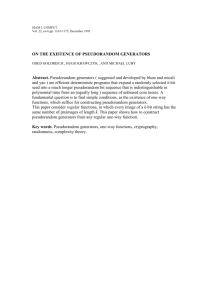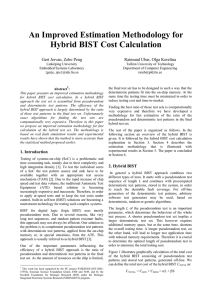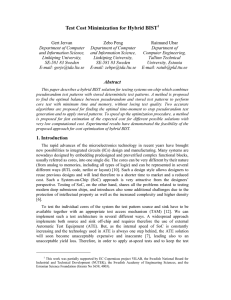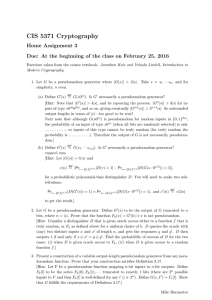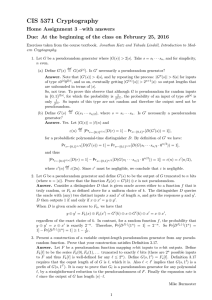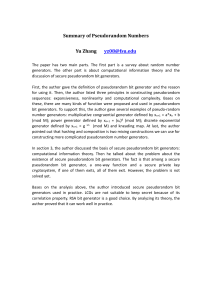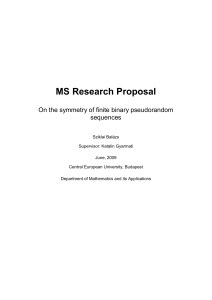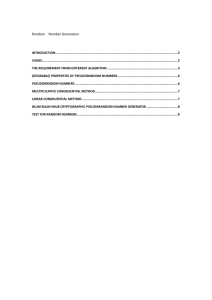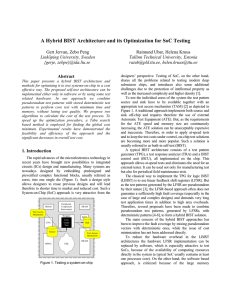Fast Test Cost Calculation for Hybrid BIST in Digital Systems
advertisement
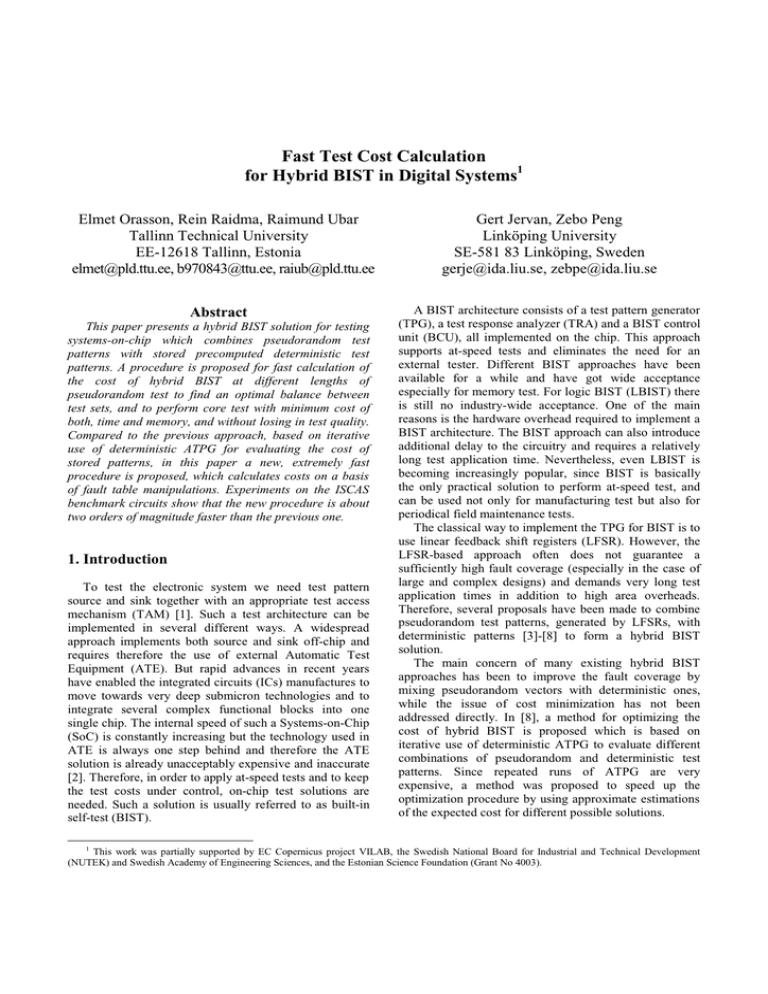
Fast Test Cost Calculation
for Hybrid BIST in Digital Systems1
Elmet Orasson, Rein Raidma, Raimund Ubar
Tallinn Technical University
EE-12618 Tallinn, Estonia
elmet@pld.ttu.ee, b970843@ttu.ee, raiub@pld.ttu.ee
Abstract
This paper presents a hybrid BIST solution for testing
systems-on-chip which combines pseudorandom test
patterns with stored precomputed deterministic test
patterns. A procedure is proposed for fast calculation of
the cost of hybrid BIST at different lengths of
pseudorandom test to find an optimal balance between
test sets, and to perform core test with minimum cost of
both, time and memory, and without losing in test quality.
Compared to the previous approach, based on iterative
use of deterministic ATPG for evaluating the cost of
stored patterns, in this paper a new, extremely fast
procedure is proposed, which calculates costs on a basis
of fault table manipulations. Experiments on the ISCAS
benchmark circuits show that the new procedure is about
two orders of magnitude faster than the previous one.
1. Introduction
To test the electronic system we need test pattern
source and sink together with an appropriate test access
mechanism (TAM) [1]. Such a test architecture can be
implemented in several different ways. A widespread
approach implements both source and sink off-chip and
requires therefore the use of external Automatic Test
Equipment (ATE). But rapid advances in recent years
have enabled the integrated circuits (ICs) manufactures to
move towards very deep submicron technologies and to
integrate several complex functional blocks into one
single chip. The internal speed of such a Systems-on-Chip
(SoC) is constantly increasing but the technology used in
ATE is always one step behind and therefore the ATE
solution is already unacceptably expensive and inaccurate
[2]. Therefore, in order to apply at-speed tests and to keep
the test costs under control, on-chip test solutions are
needed. Such a solution is usually referred to as built-in
self-test (BIST).
Gert Jervan, Zebo Peng
Linköping University
SE-581 83 Linköping, Sweden
gerje@ida.liu.se, zebpe@ida.liu.se
A BIST architecture consists of a test pattern generator
(TPG), a test response analyzer (TRA) and a BIST control
unit (BCU), all implemented on the chip. This approach
supports at-speed tests and eliminates the need for an
external tester. Different BIST approaches have been
available for a while and have got wide acceptance
especially for memory test. For logic BIST (LBIST) there
is still no industry-wide acceptance. One of the main
reasons is the hardware overhead required to implement a
BIST architecture. The BIST approach can also introduce
additional delay to the circuitry and requires a relatively
long test application time. Nevertheless, even LBIST is
becoming increasingly popular, since BIST is basically
the only practical solution to perform at-speed test, and
can be used not only for manufacturing test but also for
periodical field maintenance tests.
The classical way to implement the TPG for BIST is to
use linear feedback shift registers (LFSR). However, the
LFSR-based approach often does not guarantee a
sufficiently high fault coverage (especially in the case of
large and complex designs) and demands very long test
application times in addition to high area overheads.
Therefore, several proposals have been made to combine
pseudorandom test patterns, generated by LFSRs, with
deterministic patterns [3]-[8] to form a hybrid BIST
solution.
The main concern of many existing hybrid BIST
approaches has been to improve the fault coverage by
mixing pseudorandom vectors with deterministic ones,
while the issue of cost minimization has not been
addressed directly. In [8], a method for optimizing the
cost of hybrid BIST is proposed which is based on
iterative use of deterministic ATPG to evaluate different
combinations of pseudorandom and deterministic test
patterns. Since repeated runs of ATPG are very
expensive, a method was proposed to speed up the
optimization procedure by using approximate estimations
of the expected cost for different possible solutions.
1
This work was partially supported by EC Copernicus project VILAB, the Swedish National Board for Industrial and Technical Development
(NUTEK) and Swedish Academy of Engineering Sciences, and the Estonian Science Foundation (Grant No 4003).
The main objective of the current work is to propose a
solution to find the optimal balance between the on-line
pseudorandom test pattern generation and usage of stored
precomputed deterministic test patterns to perform core
test with minimum cost of both time and memory, without
losing test quality. We propose in this paper an algorithm
to calculate, with very low computational time, a
complete hybrid test set, and to derive from it the optimal
time-moment to stop pseudorandom test generation and to
apply deterministic patterns.
A similar problem has been addressed in [6], where an
approach to minimize testing time has been presented.
The authors have shown that hybrid BIST (or
Combination of BIST and External Test, CBET, in their
terminology) can achieve shorter testing time than pure
pseudorandom test or pure externally applied
deterministic test. The authors have made a realistic
assumption that externally applied test is much slower
than LFSR generated one and therefore internally
generated test vectors should be used as much as possible.
However, the proposed algorithm is not addressing total
cost minimization (time and memory) and is therefore
only a special case of our approach.
The rest of the paper is organized as follows. In section
2 we discuss the concepts of hybrid BIST. Section 3
introduces the algorithm to calculate the optimal hybrid
BIST set. In section 4 we present the experimental results
which demonstrate the feasibility and efficiency of our
approach. In section 5 we will draw some conclusions
together with an introduction to future work.
2. Cost Factors for Hybrid BIST
As test patterns, generated by LFSRs, are
pseudorandom by nature and have linear dependencies,
the generated test sequences are usually very long and not
sufficient to detect all the faults. To avoid the test quality
loss due to random pattern resistant faults and in order to
speed up the testing process, we have to apply
deterministic test patterns targeting the random resistant
and difficult to test faults. This hybrid BIST approach
starts with on-line generation of pseudorandom test
sequence with a length of L. On the next stage, stored test
approach takes place. For the stored approach,
precomputed test patterns, stored in the memory, are
applied to the core under test to reach 100% fault
coverage. For off-line generation of S deterministic test
patterns (the number of stored test patterns) arbitrary
software test generators may be used, based on
deterministic, random or genetic algorithms.
In hybrid BIST, the length of the pseudorandom test is
an important parameter, which determines the behavior of
the whole test process. A shorter pseudorandom test set
implies a larger deterministic test set. This however
requires additional memory space, but at the same time,
shortens the overall test process. A longer pseudorandom
test, on the other hand, will lead to longer test application
time with reduced memory requirements. Therefore it is
crucial to determine the optimal length of pseudorandom
test in order to minimize the total testing cost.
Figure 1 illustrates graphically the total cost of a
hybrid BIST consisting of pseudorandom test patterns and
stored test patterns, generated off-line. A situation is
illustrated, where 100% fault coverage is achievable with
pseudorandom vectors only, although it takes enormously
long time to do it. In the case of large and complex
designs 100% fault coverage is not always achievable,
however.
We can define the total test cost of the hybrid BIST
CTOTAL as:
CTOTAL = CGEN + CMEM
where CGEN is the cost related to the time for
generating the pseudorandom test patterns (number of
Cost
CTOTAL
Cost of
pseudorandomly
generated test
CGEN
Cost of stored
test CMEM
to reach 100%
fault coverage
Fault Coverage (%)
C min
100%
Figure 1: Cost calculation for hybrid BIST (with 100% assumption)
clock cycles), CMEM is related to the memory cost for
storing the precomputed test patterns to improve the
pseudorandom test set.
Figure 1 illustrates also how the cost of pseudorandom
test increases when striving for higher fault coverage (the
CGEN curve). In general, it can be very expensive to
achieve high fault coverage with pseudorandom test
patterns only. The CMEM curve describes the cost that we
have to pay for storing additional precomputed tests from
the fault coverage level reached by pseudorandom testing
to 100%. The total cost CTOTAL is the sum of the above
two costs. The CTOTAL curve is illustrated in Figure 1,
where the minimum point is marked as Cmin. The main
purpose of this work is to find a fast method for
calculating the curve CTOTAL to find the minimal cost Cmin.
As mentioned, in many cases 100% fault coverage is
not achievable with pseudorandom vectors only.
Therefore we have to include this assumption to the total
cost calculation and the new situation is illustrated in
Figure 2, where the horizontal axis indicates the number
of pseudorandom test patterns applied, instead of fault
coverage level. The curve for the total cost CTOTAL is still
the sum of two cost curves CGEN + CMEM with the new
assumption that the maximum fault coverage reachable by
only deterministic ATPG is achieved by the hybrid BIST.
We can also define the total cost of hybrid BIST
CTOTAL as:
CTOTAL = αL + βS
where L is the length of the pseudorandom test sequence;
S is the number of deterministic patterns; and weights α
and β reflect the correlation between the cost and the
pseudorandom test time (number of clock cycles used)
and between the cost and the memory size needed for
storing the deterministic test sequence, respectively. For
simplicity, we assume here that α = 1, and β = B where B
is the number of bytes of an input test vector to be applied
to the CUT. Hence, in the following we will use, as the
k
1
2
3
4
5
6
10
16
20
29
50
70
100
rDET(k)
155
76
65
90
44
39
104
66
44
42
51
57
16
rNOT(k)
839
763
698
608
564
525
421
355
311
269
218
161
145
FC(k)
15.593561%
23.239437%
29.778671%
38.832996%
43.259556%
47.183098%
57.645874%
64.285713%
68.712273%
72.937622%
78.068413%
83.802818%
85.412476%
cost units, number of cycles used for pseudorandom test
generation and number of bytes in the memory needed for
storing the precomputed test patterns.
Total Cost
CTOTAL
Number of remaining
faults after applying k
pseudorandom test
patterns rNOT(k)
Cost of
pseudorandom test
patterns CGEN
Cost of stored
test CMEM
Number of pseudorandom
test patterns applied, k
Figure 2: Cost calculation for hybrid BIST
In Table 1 a fragment of the results of BIST simulation
for the ISCAS’85 circuit c880 [9] is given, where
• k is the clock counter;
• rDET(k) is the number of new faults detected by the
group of test patterns generated between the last and
the current entry at k in the table;
• rNOT(k) is the number of faults not yet covered by the
sequence of patterns generated during all the k clock
cycles; and
• FC(k) is the fault coverage reached by the sequence
of patterns generated during all the k clock cycles.
In the list of BIST simulation results not all clock
cycles are presented. We are only interested in the clock
numbers at which at least one new fault will be covered,
and thus the total fault coverage for the pseudorandom
test sequence up to this clock number increases. Let us
k
149
200
323
412
708
955
1536
1561
2154
3450
4520
4521
rDET(k)
13
18
13
31
24
18
4
8
11
2
2
1
Table 1. Pseudorandom test results
rNOT(k)
132
114
101
70
46
28
24
16
5
3
1
0
FC(k)
86.720322%
88.531189%
89.839035%
92.957748%
95.372231%
97.183098%
97.585510%
98.390343%
99.496979%
99.698189%
99.899399%
100.000000%
call such clock numbers and the corresponding
pseudorandom test patterns resultative clocks and
resultative patterns. The rows in Table 1 represent the
resultative clocks, but not all (we only give some
resultative points for illustrative purpose), for the circuit
c880.
If we decide to switch from the on-line pseudorandom
test generation mode to the deterministic stored pattern
mode after the clock number k, then L = k.
Creating the curves CGEN and rNOT(k) is not difficult.
For this purpose, a simulation of the behavior of the
LSFR used for pseudorandom test pattern generation is
needed. A fault simulation should be carried out for the
complete test sequence generated by the LFSR. As a
result of such a simulation, we find for each clock cycle
the list of faults which were covered up to this clock
cycle. By removing these faults from the complete fault
list, we will know the number of faults remaining to be
tested.
More difficult is to find the values of βS, the cost for
storing additional deterministic patterns in order to reach
the given fault coverage level (100% in the ideal case).
Let t(k) be the number of test patterns needed to cover
rNOT(k) not yet detected faults (these patterns should be
precomputed and used as stored test patterns).
As an example, these data for the circuit c880 are
depicted in Table 2. Calculation of the data in the column
t(k) of Table 2 is the most expensive procedure. In [8] for
each value of k, ATPG was used to generate the test
patterns for testing not yet detected faults.
Since usage of ATPG is a very costly procedure, we
present in the following a new algorithm based on
iterative transformations of fault tables. The new
algorithm allows dramatic reduction of computation time
in the hybrid BIST cost calculations.
k
t(k)
k
t(k)
0
1
2
3
4
5
10
15
20
28
50
70
100
104
104
100
101
99
99
95
92
87
81
74
58
52
148
200
322
411
707
954
1535
1560
2153
3449
4519
4520
46
41
35
26
17
12
11
7
3
2
1
0
Table 2. ATPG results
3. Fast procedure for calculating stored test
patterns
Calculation of the data in the column t(k) of Table 2 is
the most expensive procedure. In the following section a
procedure for fast calculation of this information is
presented. Let us have the following notations:
• N is the number of all resultative patterns in the
sequence created by the pseudorandom test i.e., the
number of entries in the tables for PRG and ATPG
(see Tables 1 and 2)
• i is the current number of the entry in the tables (i
=1, 2, …, N)
• ki is the total number of the clock cycles of the
pseudorandom test sequence up to the entry i
• RDET,i is the set of faults detected (covered) by the
pseudorandom test pattern sequence which is
generated at the resultative clock signal number ki
• RNOT,i is the set of not yet detected (covered) faults
after applying the pseudorandom test pattern
sequence at the resultative clock signal number ki
• Ti is the set of stored test patterns generated by a
deterministic ATPG to cover the faults in RNOT,i.
The fault table FT for a general case is defined as
follows: given a set of test patterns T = {ti} and a set of
faults R = {rj}, FT = || εij || where εij = 1 if the test ti ∈ T
detects the rj ∈ R, and εij = 0 in the opposite case. We
denote by R(ti) ⊂ R the subset of faults detected by the
test pattern ti ∈ T.
We start the procedure for a given circuit by generating
a test set T which gives the 100% (or as high as possible)
fault coverage. This test set can be served as a stored test
if no on-line generated pseudorandom test sequence will
be used. By fault simulation of the test set T for the given
set of faults R of the circuit, we create the fault table FT.
Suppose now, that we use a pseudorandom test
sequence TL with a length L which detects a subset of
faults RL ⊂ R. It is obvious that when switching from the
pseudorandom test mode with a test set TL to the
precomputed stored test mode with a T, the test set T can
be significantly reduced. At first, by the fault subtraction
operation R(ti) - RL we can update all the contributions of
the test patterns ti in FT (i.e. to calculate for all ti the
remaining faults they can detect after performing the
pseudorandom test). After that we can use any procedure
of static test compaction to minimize the test set T.
The described procedure of updating the fault table FT
can be carried out iteratively for all possible breakpoints i
=1, 2, …, N of the pseudorandom test sequence by the
following algorithm.
Algorithm 1:
4. Experimental results
1. Calculate the whole test T = {tj} for the whole set
of faults R = {rj} by any ATPG to reach as high
fault coverage C as possible
2.
3.
4.
5.
Create for T and R the fault table FT = {R(tj)}
Take i = 1; Rename: Ti = T, Ri = R, FTi = FT
Take i = i + 1
Calculate by fault simulation the fault set RDET,i
6. Update the fault table: ∀j, tj ∈ Ti: R(tj) - RDET,i
7. Remove from the test set Ti all the test patterns tj
∈ Ti where R(tj) = ∅
8. Optimize the test set Ti by any test compaction
algorithm; fix the value of Si = | Ti | as the length of
the stored test for L = i;
9. If i < L, go to 4;
End.
It is easy to understand that for each value L = i (the
length of the pseudorandom test sequence) the procedure
guarantees the constant fault coverage C of the hybrid
BIST. The statement comes from the fact that the subset
Ti of stored test patterns is complementing the
pseudorandom test sequence for each i = 1, 2, …, N to
reach the same fault coverage reached by T.
As the result of Algorithm 1, the numbers of
precomputed deterministic test patterns Si = |Ti| to be
stored and the subsets of these patterns Ti for each
i =1, 2,…, N are calculated. On the basis of this data the
cost of stored test patterns for each i can be calculated by
the formula CMEM = βSi. From the curve of the total cost
CTOTAL(i) = αL + βS the value of the minimum cost of the
hybrid BIST min {CTOTAL (i)} can be easily found.
Circuit
C432
C499
C880
C1355
C1908
C2670
C3540
C5315
C6288
C7552
LPR
780
2036
5589
1522
5803
6581
8734
2318
210
18704
LDET
80
132
77
126
143
155
211
171
45
267
CPR
93.02
99.33
100.00
99.51
99.48
84.92
95.54
98.89
99.34
93.67
CDET
93.02
99.33
100.00
99.51
99.48
99.51
95.54
98.89
99.34
97.14
N
81
114
114
109
183
118
265
252
53
279
Experiments were carried out on the ISCAS’85
benchmark circuits for investigating the efficiency of the
method for optimizing the hybrid BIST and for comparing
with the previous algorithm used in [8]. Experiments were
carried out using Turbo Tester toolset [10], [11] for
deterministic test pattern generation and fault simulation,
and using the test compaction tool [12]. The results are
presented in Table 3.
In the columns of Table 3 the following data is
depicted: ISCAS’85 benchmark circuit name, LPR - length
of the pseudorandom test sequence, LDET - the number of
test patterns generated by the deterministic ATPG, CPR the fault coverage of the pseudorandom test sequence,
CDET - the total fault coverage of the hybrid BIST (after
applying deterministic test patterns), N - number of all
resultative patterns in the pseudorandom test sequence, TG
- the time (sec) needed for ATPG to generate the
deterministic test set, TA - the time (sec) needed for
carrying out manipulations on fault tables (subtracting
faults, and compacting the test set), TOLD - the time (sec)
needed for calculating the cost curve for hybrid BIST by
the previous method [8], TNEW - the time (sec) needed for
calculating the cost curve for hybrid BIST by the new
proposed method, the advantage of the proposed method
compared to the previous one as the relation TOLD/TNEW.
The total testing time for both methods were calculated as
follows:
TOLD = N * TG
TNEW = TG + N * TA.
In fact, the values for TG and TA differ for the different
values of i = 1,2, …, N. However the differences were in
the range of few percents, which allowed us to neglect
this impact and to use the average values of TG and TA.
TG
20.10
0.65
0.15
1.22
11.65
1.95
85.29
10.29
3.79
53.78
TA
0.01
0.02
0.02
0.03
0.07
0.09
0.14
0.11
0.04
0.27
TOLD
1632.9
74.1
17.1
133.0
2132.0
230.1
22601.9
2593.1
200.9
15004.6
Table 3. Experimental results. Comparison of two algorithms
TNEW
21.0
2.9
2.4
4.5
24.5
12.6
122.4
38.0
5.9
129.1
TO/TN
77.75
25.55
7.13
29.56
87.02
18.25
184.66
68.24
34.05
116.22
Circuit
LMAX
LOPT
SMAX
SOPT
Bk
CTOTAL
C432
C499
780
2036
91
78
80
132
21
60
4
6
186
386
C880
C1355
5589
1522
121
121
77
126
48
52
8
6
481
388
C1908
C2670
5803
6581
105
444
143
155
123
77
5
30
612
26867
C3540
C5315
8734
2318
297
711
211
171
110
12
7
23
889
985
C6288
C7552
210
18704
20
583
45
267
20
61
4
51
100
2161
Table 4. Experimental results. Parameters for optimized hybrid BIST
The switching point from the PRG mode to the stored
deterministic patterns mode was found at the minimum of
CTOTAL. In Table 4 the parameters of optimized hybrid
BIST are depicted: ISCAS’85 benchmark circuit name,
LMAX - the maximum length of the simulated
pseudorandom test sequence, LOPT - the length of the
pseudorandom test sequence for the optimized BIST, SMAX
- the maximum number of test patterns generated by the
deterministic ATPG, SOPT - the number of stored test
patterns for the optimized BIST, Bk - the number of bytes
needed for storing the input test pattern for the circuit k,
and CTOTAL - the total cost of the optimized hybrid BIST,
calculated by the formula CTOTAL =LOPT + Bk*SOPT.
In Figure 3, the curves of the cost CGEN =L (denoted on
Fig.3 as T) for on-line pseudorandom test generation, the
cost CMEM = Bk*S (denoted as M) for storing the test
patterns, the number |RNOT| of not detected faults after
applying the pseudorandom test sequence (denoted as Fr),
and the total cost function CTOTAL are depicted for
selected benchmark circuits C432, C499, C880, C1908,
C3540 and C7552 (Sc = 0 is used as a constant in the cost
function formula).
5. Conclusions and future work
This paper describes a hybrid BIST solution for testing
systems-on-chip. It combines on-line pseudorandom test
pattern generation with using precomputed and stored
deterministic test patterns. For selecting the optimal
switching moment from pseudorandom patterns mode to
the stored deterministic patterns mode, a fast algorithms
to calculate the total cost is given.
As it was shown by experimental results, the new cost
calculation algorithm calculates the total cost of the
hybrid BIST much faster (7 - 184 times faster) than
previously proposed algorithm and can therefore speed up
the total cost minimization process significantly.
As a future work we would like to investigate
possibilities to use the proposed approach for parallel
testing issue (testing multiple cores at the same time) and
to use the same ideas in case of sequential cores.
6. Acknowledgements
The authors appreciate the work of Jaan Raik from
Tallinn Technical University for developing the software
tools used for the experimental work, and providing
support for the experiments.
7. References
[1]
Y. Zorian, E. J. Marinissen, S. Dey, “Testing Embedded
Core-Based System Chips,” IEEE International Test
Conference (ITC), pp. 130-143, Washington, DC, October
1998. IEEE Computer Society Press.
[2]
The National Technology Roadmap for Semiconductors,
Semiconductor Industry Assoc., San Jose, Calif., 1997,
1998
[3]
M. Chatterjee, D. K. Pradhan, “A novel pattern generator
for near-perfect fault-coverage,” VLSI Test Symposium,
pp. 417-425, 1995
[4]
S. Hellebrand, S. Tarnick, J. Rajski, B. Courtois,
“Generation Of Vector Patterns Through Reseeding of
Multiple-Polynomial Linear Feedback Shift Registers,”
IEEE Int. Test Conference (ITC’92), pp. 120-129,
Baltimore, 1992
[5]
S. Hellebrand, H.-J. Wunderlich, A. Hertwig, “MixedMode BIST Using Embedded Processors,” Journal of
Electronic Testing: Theory and Applications,” pp. 127138, No. 12, 1998
[6]
M. Sugihara, H. Date, H. Yasuura, “Analysis and
Minimization of Test Time in a Combined BIST and
External Test Approach,” Design, Automation & Test In
Europe Conference (DATE 2000), pp. 134-140, Paris,
France, March 2000
[7]
N. Zacharia, J. Rajski, J. Tyzer, “Decompression of Test
Data Using Variable-Length Seed LFSRs,” 13th VLSI Test
Symposium, pp. 426-433, 1995.
[8]
G. Jervan, Z. Peng, R. Ubar, “Test Cost Minimization for
Hybrid BIST.” The IEEE International Symposium on
Defect and Fault Tolerance in VLSI Systems, pp.283-291,
Yamanashi, Japan, October 2000.
[9]
F. Brglez, P. Pownall, R. Hum. “Accelerated ATPG and
fault grading via testability analysis,” IEEE Int. Symp. on
Circuits and Systems, pp. 663-698, June 1985.
[10] G. Jervan, A. Markus, P. Paomets, J. Raik, R. Ubar,
“A CAD system for Teaching Digital Test,” 2nd European
Workshop on Microelectronics Education, pp. 287-290,
Noordwijkerhout, the Netherlands, May 14-15, 1998.
[11] Turbo Tester Reference Manual. Version 3.99.03. Tallinn
Technical University 1999. http://www.pld.ttu.ee/tt
[12] A.Markus, J.Raik, R.Ubar, “Test Set Minimization Using
Bipartite Graphs,” Proc. of the 6th Baltic Electronics
Conference, pp. 175-178, Tallinn, Estonia, October 1998.
Figure 3. Cost curves of hybrid for ISCAS’85 benchmark circuits
